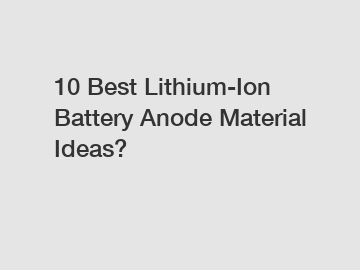Mar. 15, 2024
Minerals & Metallurgy
Link to Lianjing
Lithium-ion batteries are widely used in a variety of applications, from consumer electronics to electric vehicles. The performance of these batteries depends heavily on the materials used to construct them, particularly the anode material. Anode materials play a crucial role in determining the battery's energy density, cycling stability, and overall performance. In recent years, researchers have been exploring new and innovative materials to improve the performance of lithium-ion batteries. Here are ten of the best lithium-ion battery anode material ideas that show promise for future applications.
Graphene.

Graphene is a two-dimensional material composed of a single layer of carbon atoms arranged in a hexagonal lattice. It has excellent electrical conductivity, mechanical strength, and surface area, making it an ideal candidate for lithium-ion battery anodes. Graphene-based anodes have shown improved cycling stability, high capacity, and fast charging capabilities compared to traditional graphite anodes.
Silicon.
Silicon has a high theoretical capacity for lithium-ion storage, making it an attractive material for anodes. However, silicon undergoes significant volume changes during lithiation and delithiation, leading to mechanical degradation and poor cycling stability. Researchers have been working on nanostructured silicon materials and silicon composites to address these challenges and improve the performance of silicon anodes.
Metal oxides.
Metal oxides, such as tin oxide, titanium oxide, and iron oxide, have also been studied as potential anode materials for lithium-ion batteries. These materials offer high capacity and low cost compared to graphite anodes. However, they suffer from poor electrical conductivity and volume changes during cycling. Nanostructuring and surface modifications have been proposed to enhance the electrochemical performance of metal oxide anodes.
Carbon nanotubes.
Carbon nanotubes are one-dimensional nanomaterials with excellent electrical conductivity and mechanical properties. They have been investigated as anode materials for lithium-ion batteries due to their high surface area and good lithium diffusion kinetics. Functionalization of carbon nanotubes with metal nanoparticles or polymers can further improve their electrochemical performance.
Metal sulfides.
Metal sulfides, such as molybdenum disulfide and iron sulfide, are attractive anode materials for lithium-ion batteries due to their high theoretical capacity and low cost. However, metal sulfides suffer from poor electrical conductivity and volume changes during cycling. Strategies such as nanostructuring, doping, and surface coatings have been proposed to enhance the performance of metal sulfide anodes.
Conducting polymers.
Conducting polymers, such as polyaniline and polypyrrole, have emerged as promising anode materials for lithium-ion batteries. These materials combine the electrical conductivity of metals with the flexibility and processability of polymers. Conducting polymers can offer high capacity, fast charge/discharge rates, and mechanical flexibility for wearable electronic devices.
Carbon-based composites.
Carbon-based composites, such as carbon nanotube-graphene hybrids and carbon-silicon composites, have been developed to combine the advantages of different materials for lithium-ion battery anodes. These composites can provide high capacity, improved cycling stability, and enhanced rate performance compared to single-component materials.
Nanocomposites.
Nanocomposites consisting of nanoscale inorganic particles embedded in a carbon matrix have shown great potential as anode materials for lithium-ion batteries. These materials combine the high capacity of metal oxides or sulfides with the excellent conductivity and mechanical stability of carbon materials.
Solid electrolyte interphase (SEI) engineering.
The solid electrolyte interphase (SEI) is a critical component that forms on the surface of the anode during battery cycling. Researchers have been working on engineering the SEI layer to improve its stability, ion conductivity, and compatibility with different anode materials. Strategies such as surface coatings, electrolyte additives, and polymer binders can help enhance the performance and lifespan of lithium-ion batteries.
In conclusion, the development of new anode materials is essential for advancing lithium-ion battery technology and meeting the growing demand for high-performance energy storage devices. The ten ideas outlined above represent some of the most promising directions for improving lithium-ion battery anodes. Continued research and innovation in this field will be crucial for achieving the next generation of lithium-ion batteries with higher energy density, faster charging rates, and longer cycle life.
If you have any questions or would like to learn more about lithium-ion battery anode materials, please feel free to contact us. Our team of experts is here to help you navigate the latest advancements in battery technology.
If you want to learn more, please visit our website.
Are you interested in learning more about artificial Graphite Block? Contact us today to secure an expert consultation!
If you are interested in sending in a Guest Blogger Submission,welcome to write for us!
All Comments ( 0 )